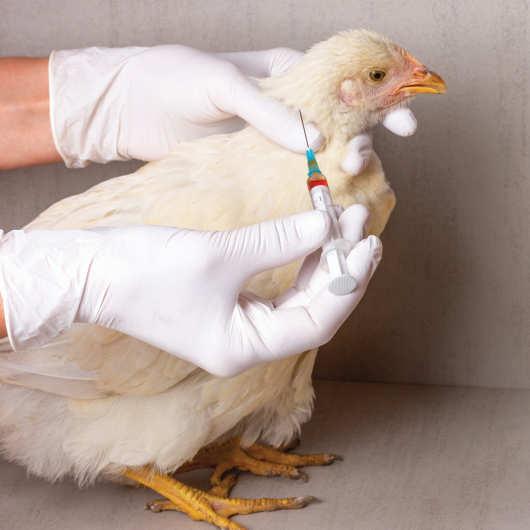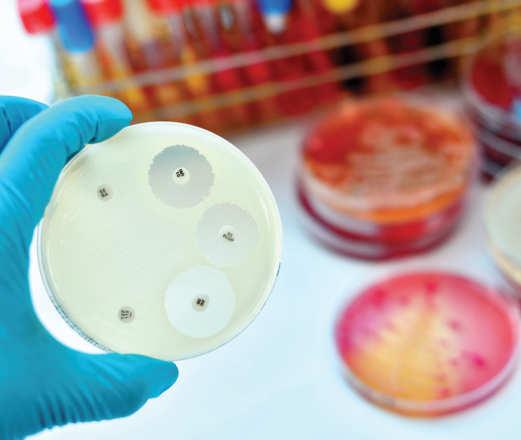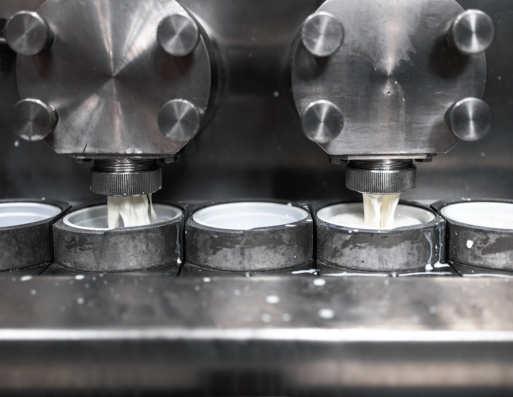
10 minute read
Stalosan F revealed to be capable of killing ASF and FMD viruses
A NEW EFFICACY test from Vietnam, distributed by San Group, reveals a piece of break-through information about the Stalosan F efficacy against a variety of disease-causing microorganisms, including the Foot and mouth disease (FMD) and African swine fever (ASF) viruses.
FMD, which affects cattle, buffaloes, pigs, sheep, goats, and around 70 wildlife species, is estimated to circulate in 77% of the global livestock population in Africa, the Middle East and Asia, as well as in a limited area of South America. Although FMD is a disease of low mortality, the global impact is colossal due to the huge numbers of animals affected. It spreads quickly and causes significant economic losses, due to reduced production and losses caused by costs of FMD control and limited access to markets. The annual global economic impact of FMD has recently been estimated at US$11bn in endemic areas and an additional minimum of US$1.5bn was ascribed to virus incursions into FMD-free countries.
Another important pathogen, responsible for massive losses in pig populations and drastic economic consequences, ASF has become a major crisis for the pork industry in recent years. With no effective vaccine, the disease is not only impeding animal health and welfare but has also detrimental impacts on biodiversity and the livelihoods of farmers.
In total, since January 2020, ASF has been reported as present in five different world regions in 39 countries, affecting more than 1,125,000 pigs and 36,000 wild boars, resulting in around 1,960,000 animal losses.
Against this background, the Stalosan F efficacy test against bacteria and HPAI v, FMD and ASF, made by the National Centre of Veterinary Diagnostics in Vietnam, has added significant value to the broad-spectrum efficacy against a variety of pathogens, showing that it has a completely inactivating effect on the types of bacteria Escherichia coli, Salmonella sp., Staphylococcus sp. and Streptococcus sp. as well as the disease-causing viruses FMD, Blue Ear (PRRSV), ASF and the highly virulent avian influenza (HPAIV H5N1). It also shows that the effect of Stalosan F antiseptic can last for at least seven days.
Having in hand a powerful tool such as Stalosan F, capable of killing ASF and FMD viruses, can make the difference in the global fight for sustainable animal production, if applied as a part of strict biosecurity procedures.
Eritrean Ministry of Agriculture announces production of two animal disease vaccines
THE ERITREAN MINISTRY of Agriculture has announced that it has produced two internationally certified animal disease vaccines through the National Animal and Plant Health Laboratory based in Villagio, Asmara.
According to Efrem Gebremeskel, director of the National Laboratory, the two vaccines produced are PPR–against small ruminant disease and Newcastle–an important poultry disease. Gebremeskel explained that the two vaccines were selected for production since they could address two very important diseases which otherwise had to be imported at a much higher cost.

He further outlined the importance of these two vaccines in terms of self-reliance, saving hard currency, shortening the procurement process during outbreaks of diseases, and also strengthening the country’s production capacity with young experts taking centre stage.
Regarding the quality of the vaccines, Gebremeskel indicated that standard quality control measures were conducted at the national level through the National Animal and Plant Health Laboratory Quality Control, and the Ministry’s Regulatory Services as well as internationally by the African Union Pan African Veterinary Vaccine Centre, an international quality control institute delegated by the Food and Agricultural Organisation (FAO) and World Animal Health Organisation.
Gebremeskel also commended the all-round support the National Animal and Plant Health Laboratory provided by the relevant Government institutions and partners, while further noting that the National Animal and Plant Health Laboratory had planned to produce two more vaccines for infectious bronchitis and sheep and goat pox. Moreover, he commended the all-round support the
National Animal and Plant Health Laboratory was provided by the relevant government institutions and partners. The laboratory was established in 1903 and used to produce vaccines until 1972.
After Independence, the Government of Eritrea in cooperation with partners made a concerted effort to renovate the laboratory, which has led to this success story.
Novus International puts the focus on intelligent nutrition
NOVUS INTERNATIONAL INC, the global feed additive company, hosted a press conference during the World Pork Expo in Iowa to reveal its comprehensive rebranding initiative. The changes reflect the 32-year-old company’s promise to deliver more to its customers and its commitment to providing solutions created through advanced technology, based on global scientific research that goes further to offer unexpected benefits to customers.
“Intelligent nutrition is how we support animal health and performance,” said NOVUS SVP and chief commercial officer Ed Galo from the Iowa State Fairgrounds.
“Our novel combination of experienced people, insightful perspective, and smarter solutions allows us to put more into everything we create, because we want to deliver more benefits that deliver more for producers. That is intelligent nutrition.”
The company has refocused its attention on where it can best support its customers by addressing challenges and opportunities in production. The NOVUS product portfolio includes solutions to those challenges in the form of amino acids, organic bis-chelated trace minerals, organic acids, enzymes, and essential oils. NOVUS also leads the way in embedding functional ingredients in grain through INTERIUS technology.
“We have experienced significant growth since 1991,” Galo said. “In the last few years, we have honed in on what we can uniquely provide to poultry and livestock producers, nutritionists, feed mills, and distributors around the world –solutions offering something extra. Services and solutions that are made of more.”
‘Made of More’, the company’s new slogan, represents the focus of all its future endeavors.
“Just as producers are asked to do more with their poultry and livestock – more growth, more efficiency, more yield – our experience and our solutions offer more to help them reach their production goals,” said Abishek Shingote, NOVUS associate VP of Global Strategic Marketing – Technology & Innovation.
NOVUS liquid and dry methionine solutions utilise the HMTBa molecule, which is a precursor to L-methionine. Because of this unique molecule, ALIMET feed supplement, MHA feed supplement and MFP feed supplement are nitrogen-free and have properties of an organic acid benefiting overall gut health. Liquid ALIMET feed supplement requires virtually no handling thanks to the company’s automated inventory system for customers (AIMS). HMTBa is also the backbone for MINTREX bischelated trace minerals, highly bioavailable and absorbable organic zinc, copper, and manganese that allow producers to use lower inclusion of minerals in the ration while seeing the same or improved performance and growth. MINTREX is
Skretting introduces new feed for shrimp farms
SKRETTING HAS INTRODUCED Elevia, a new, innovative feed engineered to offer superior nutrition and water quality in shrimp hatcheries and nurseries. The precisely produced, stable micro diet improves larval performance while simplifying feed management and ensuring a cleaner system.
Formulated to mimic the natural feeding approach of shrimp larvae, Elevia is a next generation solution that surpasses conventional feeding methods and traditional aquafeed ingredients, setting a new standard for hatchery performance. Incorporating new sustainable raw materials such as essential long-chain omega-3 fatty acids, algae-derived DHA and hydrolysed marine proteins, it enables shrimp to develop into strong and healthy post larvae with increased capacity to thrive in nursery environments.
“Elevia reduces the production cycles in hatcheries and provides shrimp with the necessary energetic reserve to improve resilience for transportation to the farm and acclimatation,” said Marita Montserrate, technical director at Skretting Ecuador. “In addition, Elevia ensures better performance in nursery, reduces the cost of the post larvae and promotes increased survival and growth throughout the entire production cycle.”
Elevia improves the ability of shrimp to handle challenges by providing them with nutrients that improve their immune system and overall resilience. This enables the shrimp to cope more effectively with stressful environmental changes. As a result, shrimp production becomes more reliable and successful, reducing the risks associated with variations in water conditions and other factors.
Through Elevia's advanced formulation, physical properties and colour, the need for multiple diets and flakes is significantly reduced, also a source of methionine through HMTBa. ACTIVATE nutritional feed acid is made from a blend of organic acids and HMTBa shown to reduce the survivability of certain pathogens in feed. “These products provide more than what customers have come to expect from traditional organic trace minerals or organic acid solutions,” said Shingote. Just as NOVUS works to do more for its customers, it’s also working to offer more to the industry. resulting in simplified operations and feed management. Another key feature that contributes to streamlining operations is the diet's ability to maintain water stability. Thanks to its unique composition and encapsulation of omega-3 fatty acids, the leaching of lipids into the production system is prevented, ensuring cleaner and uncompromised water quality. Consequently, intact feed particles remain stable for extended periods, minimising the necessity for frequent replacements. This not only promotes optimal water conditions but also facilitates essential system maintenance, all while alleviating the strain on bio- and mechanical-filters.
Galo said new products – created in-house, through partnerships, or via mergers and acquisitions – are on the horizon. “Innovation remains our core priority. As experts in the global food system, we can see where the animal protein industry is heading and this vision directs how we can help meet regional goals from performance and environmental sustainability to return on investment,” he said. “We are driven to create new ideas and technologies that improve the health of animals and animal protein production.
“We are very excited about introducing Elevia to the shrimp hatcheries, particularly in Ecuador as our first launch country. We are confident that once again Skretting is paving the way for a new generation of shrimp hatchery production and facilitating improved post larvae quality,” said Eamonn O’Brien, global product manager LifeStart at Skretting.
Elevia is produced in Skretting’s state-of-the-art LifeStart facility in France, and is currently available in Ecuador, with other markets to follow.
Skretting is a global leader in providing innovative and sustainable nutritional solutions and services for the aquaculture industry. With production facilities in 18 countries on five continents, it manufactures and delivers high quality feeds from hatching to harvest for more than 60 species. The total annual production volume of feed is more than 3mn tonnes.
Skretting is the aquaculture business line of Nutreco, a world leader in animal nutrition. Skretting's global operations are based in Stavanger, Norway. It has 3,800 employees worldwide.
Zimbabwe starts developing 2.0 One Health AMR National Action Plan
ZIMBABWE WAS ONE of the first African countries to put in place its NAP with the objective of reducing the drug resistance index standing at 66.6% against a benchmark of 25%.
The Government of Zimbabwe has commenced updating its antimicrobial resistance (AMR) National Action Plan (NAP) 2023-2027, to replace the previous NAP (2017-2021) which had lapsed.

The review provides an opportunity to assess the impact of activities carried out during the last five years and assist with developing evidence-based policies and decisions and evaluate procedures and indicators that could be adopted to achieve strategic objectives within the new plan. Updating NAP will help determine the necessary interventions to address AMR, leaning on a comprehensive 'One Health' approach and promoting cooperation and coordination between sectors at the national level.
The use of NAPs, which have well-defined goals, strategies, and policies as well as frameworks, is essential in the fight against AMR. During the implementation of Zimbabwe's old NAP, a number of achievements were noted. Zimbabwe was also one of the first African countries to put in place its NAP with the objective of reducing the drug resistance index standing at 66.6% against a benchmark of 25%. The World Health Organisation (WHO) is currently coordinating the creation of a One Health Dashboard by integrating laboratory information systems from all the One Health sectors in Zimbabwe to enable real-time sharing of data.
The United Nations, through FAO and WHO continues to support the Government of Zimbabwe to reducing the drug resistance index and strengthening the One Health Initiative. The following areas are being supported: implementing action of national plans, developing guidance, advice and tools, and gathering data and evidence to shape policies and drive action.
“The momentum is now there, and it is important for the
Government of Zimbabwe to keep building on these achievements to deal with AMR,” said Stanley Midzi, WHO Zimbabwe Health Systems Strengthening technical officer.
The United Nations, through FAO and WHO continues to support the Government of Zimbabwe to reducing the drug resistance index and strengthening the ONE Health Initiative. The following areas are being supported; implement action of national plans, developing guidance, advice and tools and gathering data and evidence to shape policies and drive action.
Trouw Nutrition launches MyMilkPrint to calculate impact of milk on the environment

TROUW NUTRITION HAS launched MyMilkPrint, a service which allows feed advisors to calculate the environmental impact of milk at the farm level, enabling them to develop effective emission reduction strategies for dairy producers.
To remain competitive in an increasingly sustainability-oriented marketplace, dairy producers are being challenged to measure and reduce the environmental impact of their products. Early adopters of more sustainable practices are already benefitting from a clear competitive advantage, making value-chain transparency a key selling point. Others are still exploring where to begin their ‘sustainability journey’ and what they can do on the farm level to make their milk production more sustainable. Feed advisors have a key role to play in this transition.
Providing in-depth insights
Trouw Nutrition is addressing the growing need for transparency around the sustainability of milk with the launch of MyMilkPrint, a onestop online environmental footprint service for milk production. The new service, integrated into Trouw Nutrition’s MyNutriOpt digital platform, uses farm-specific inputs such as milk production, on-farm energy use, and farm-grown ingredients, combined with data on purchased feeds and nutritional data. These inputs are then translated into an accurate estimate of the environmental impact per kg of farm-gate milk produced.
MyMilkPrint requires no specialist knowledge and minimal set-up and training. With just a few clicks, feed advisors can uncover emission hotspots, and identify effective strategies to reduce the environmental impact of their client’s milk, without compromising on milk production or animal performance. For example, replacing a fat or protein source in a feed ration with an alternative ingredient that has a lower environmental footprint can lead to significant reductions in the total impact of the feed ration. This in turn, reduces the ecological impact of the milk produced.
For dairy producers, the insights and reports provided by MyMilkPrint can easily be shared, helping to develop more sustainable practices and forge closer ties with downstream business partners such as supermarkets, wholesalers, and food processors.
African Farming speaks with Bühler Nigeria's managing director, Manuel Murrenhoff, regarding the company's efforts to support West Africa in achieving food security and rice self-sufficiency.










